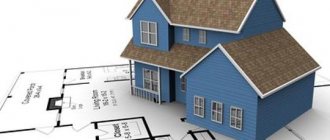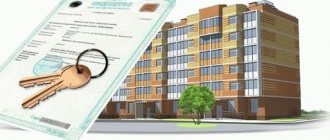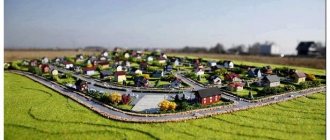A technical passport of a property is an information and reference document that reflects the actual condition of the property. The technical passport (technical passport) records data on the area of the room, the number of rooms, the material from which the partitions and walls of the room are composed, all technical and identification characteristics.
The registration certificate is produced for official use: if necessary, it is presented to the guardianship and trusteeship authorities, banks, courts, etc. This document is drawn up based on the results of a state technical inspection.
The presence of a technical passport is necessary to confirm the status of the owner of the property. Without this document it is impossible to sell, rent or mortgage the property.
Faced with the need to prepare this document, many owners ask questions: what is the procedure for obtaining a technical passport? Is it possible to independently calculate the cost of a technical inspection of a property? Where can I find out the prices, and are there any benefits for certain categories of owners? Let's try to figure it out.
Registration certificate for an apartment and house: how much does it cost and how to get it >>>
Follow-up examination
A subsequent inspection is carried out in the event of a change in the identification or technical characteristics of the property or their individual components during their redevelopment, refurbishment or reconstruction. The only exceptions are those cases when these changes can be indicated in the registration certificate without conducting a subsequent survey, for example, when changing the cadastral number or location. The subsequent examination is carried out free of charge without an on-site examination if the change in identification characteristics was made by decision of government authorities.
Based on the results of the subsequent inspection, a new technical passport is issued, which reflects all changes identified in the characteristics of the property.
How to measure the area of an apartment? >>>
Technical passport of the land plot
Content:
Any real estate property must have two passports - cadastral and technical, which reflect all the necessary information. Typically, the technical passport of a land plot contains more extensive information about the allotment, and also necessarily includes information about the construction of a residential or non-residential facility in the form of a building, house, garage or shed.
In some cases, it may be an integral part of the cadastral passport and serve as the legal basis for obtaining all the information necessary for the notary.
The need to obtain an extract from the technical passport usually arises when selling, purchasing a plot of land or registering a deed of gift. However, it can be obtained subject to the official registration of the land plot in a unified register, for which a person must have a cadastral passport in hand.
If it is not there, then such an official document must be drawn up as early as possible, since only in this way can the site be fully disposed of.
It should be noted that any technical passport, unlike a cadastral passport, is obtained from the BTI, but this should be done after completion of construction on the land plot. Before this, the main document that regulates all legal relationships is the cadastral passport for the land.
Even if a citizen receives land from the state for residential development, he is required to obtain a passport, as this gives him the right to carry out land and construction work.
If any difficulties or problems arise, our law firm will be happy to provide comprehensive assistance in resolving them, guaranteeing assistance in a short time. Thus, if for some reason you are unable to obtain a technical passport yourself, please contact us.
Consultations are conducted in person and remotely, online.
Stages of identifying technical characteristics
The technical data sheet must reflect the currently valid characteristics. Identifying the technical characteristics of a property consists of several mandatory points:
- drawing up a land plot plan (LP) indicating the actual boundaries and drawing buildings and structures on this plan;
- drawing up floor plans of the main buildings located on the site;
- technical description of the structural elements of all buildings and structures located on the site, with a determination of their technical condition;
- carrying out computational work with recording of the survey results in the technical passport of the property.
All this work is carried out with a specialist visiting the site.
How to obtain a technical passport for land
Applications are accepted through an interactive resource and after reviewing the documents, a time and date of issue are set. Necessary documents To order a technical passport from the BTI for the land plot on which the building is located, you must:
- certificate of right to use the land plot;
- cadastral passport;
- permits for construction;
- certificate of ownership of property;
- civil passport of the owner or authorized representative;
- receipt for payment of services.
A sample technical passport for a land plot is here. The price for providing services to the BTI is set by local authorities and does not differ from the cost of work performed by the cadastral chamber.
Price The BTI tariff schedule for the preparation of technical documentation contains prices depending on the area of buildings and the speed of work.
- The service provision period has been exceeded.
- Unlawful refusal to issue a cadastral passport.
- Request for additional documents.
- Refusal to accept documents from the applicant for obtaining a cadastral passport, if they are prepared in accordance with current legislation, etc.
Drawing up a land plot plan
The technical plan is drawn up based on the results of a survey conducted by a field specialist.
The buildings located on the land plot are technically divided into main and service buildings.
The main one is the building that, by its purpose, capital construction and architectural features, is the main one on the land plot. A plot of land may contain one or more main buildings.
Service buildings include those structures that play a secondary role in relation to the main structure. Such buildings are garages, sheds, bathhouses, etc.
Structures and buildings located on a land plot are measured along the perimeter and tied to certain reference points, which is necessary for an accurate plan. The measurement is made according to the base.
In cases where, instead of a plinth, a building has an insulating earth fill, the building is measured for the plan along its walls, and the fill is not introduced into the building. The site plan does not include temporary structures or portable equipment. However, cesspools, wells, etc. are marked on the plan and subject to measurement.
All buildings, structures and extensions marked on the technical plan are assigned a letter. Capital letters of the Russian alphabet are used to designate the main buildings: A, B, V, etc. indicating the number of storeys, purpose and material of the walls. The exception is the letter G, which is used to designate office premises. Extensions to the main premises, both residential and non-residential, are written in the same capital letters as the main building to which they belong, but with the addition of an ordinal numerical value: A1, A2, etc. Extensions such as verandas, terraces, vestibules, etc. are written in lowercase letters of the Russian alphabet, corresponding to the main structure to which they belong: a1, b2, etc.
When measuring the facade of a site, not only the total length of the site is measured, but also the fence, building, gates, gates - all components of its length separately. As a result, the sum of the lengths of the individual parts must coincide with the total length. The sides of the site are measured along the boundaries.
If there is a fence on the border, measurements are taken taking into account its thickness. The boundaries on which stone or brick fences are located are also calculated. If there are fences made of timber, the height is also taken into account. Fences and fences that are thick are drawn on the plan with a double line indicating their thickness to scale.
All kinds of structures - gates, fences, water pipes, sheds, etc. - are indicated on the technical plan by Roman numerals.
The external height marked in the outline of the building is indicated by the letter H. In cases where the building is located on a slope and the height was measured at several points, the arithmetic mean value is indicated in the plan. The dotted lines on the site plan indicate the contours of cellars, basements and semi-basements. Mezzanines and attics are also shown with a dotted line on the outline of the building.
Real estate transactions online >>>
Information about the plot in the cadastral passport
The cadastral passport contained 5 sections:
- B1 – general information: exact address, unique cadastral number, cadastral value, area of the plot, type of land and permitted use/purpose, owner’s rights and land survey boundaries, date of entry of the number into the state real estate cadastre.
- B2 – drawing plan and diagram of the land plot on the stated scale with an explanation.
- B3 – encumbrance of the land plot and property rights (if there is any encumbrance).
- B4 – description of the boundaries of the site, specifying the angles and dimensions.
- B5 – clarification of turning points within the boundaries of the site.
Sample cadastral passport for a land plot
(Click on the picture to enlarge →)
Drawing up a floor plan
When drawing up a plan, the following definitions are used: total, residential, non-residential and usable areas:
- The living area of the house consists of the area of the living rooms; the area of the built-in wardrobes is not taken into account. The living area of an apartment consists of the sum of the areas of living rooms.
- The non-residential area consists of the areas of internal utility rooms: kitchen, bathroom and toilet, as well as a corridor, pantry, hallway, etc.
- The usable area of a dwelling is the sum of residential and non-residential area.
- The total area of the apartment consists of the sum of the usable area of the home and the areas of balconies, loggias, verandas and terraces, which are calculated using certain reduction factors: for balconies and terraces - 0.3, loggias - 0.5, verandas - 0.8. For combined loggias and balconies, a reduction factor of 0.4 is applied.
When drawing up a floor plan, internal and external measurements of the main building and extensions must be taken. All premises and rooms in them, without exception, are subject to measurement, also taking into account the premises of basements and semi-basement floors, mezzanines, attics and all rooms located in the extensions of the building, not excluding cold buildings.
The main building with external extensions is measured along the perimeter at the level of the first floor windows. In the event that the height of the buildings is the same, but they have different number of storeys, measurements are taken for each part separately.
Measurements inside the building are made between the surfaces of walls and partitions at floor level, skirting boards are not taken into account.
Built-in wardrobes and niches in the walls are measured and drawn on the plan, but are not included in the total area of the room. Niches for central heating devices, which are located under the windows, are not subject to measurement and are not indicated on the plan. Niches whose height exceeds 1.8 m and niches in the openings of sealed doors are measured, marked on the plan and included in the total area of the room. If the rooms of a room are connected to each other by arches whose width is 2 meters or more, or by openings more than 1.5 meters wide, and the length of these openings is at least 50% of the length of the smaller room and there are no boxes, then such rooms are considered one room. Rooms that are connected by several openings with supporting pillars present are also measured as one room. Arched openings sealed with a partition are also measured and taken into account when calculating the total area. The area of the partition is not taken into account. Portable and temporary ovens are not marked on the floor plan. They are not measured.
Cost of government services
The fee for state technical inspection of real estate is established in accordance with the legislation of the Republic of Kazakhstan and is collected by state enterprises that carry it out.
Responsibility for compliance with the approved cost of technical inspection services is assigned personally to each of the immediate managers of real estate centers.
At the moment, there is a price list for services provided to owners during the state technical inspection of real estate, introduced in April 2011. This document contains information on the cost of the service relating to all types of real estate, both residential and office, and industrial. The prices indicated in it apply to everyone, regardless of their form of ownership. You can view the full version of this document on the website of the Ministry of Justice of the Republic of Kazakhstan adilet.gov.kz.
The full cost of the state technical inspection service is summed up from three main components:
- base cost, which does not depend on the area of the main buildings and the area of the land;
- the cost of state technical inspection of a land plot (directly proportional to the area of land);
- the cost of examining the OS - the main structure (directly proportional to its area).
The basic cost of state technical inspection is established once for any land plot. When calculating the cost of technical inspection of a storage facility, only its actual area is taken into account. When calculating the cost of surveying apartments in multi-apartment residential buildings (MRD), the total area of the premises is considered.
According to the current price list, the basic cost of the initial inspection of an apartment in the Moscow Railway will be 2472 tenge; private house - 3096 tenge; garage - 2677 tenge; dachas - 3105 tenge; multi-apartment residential building - 7971 tenge; industrial facility - 7108 tenge; other non-residential properties - 4413 tenge.
The cost of the service during a subsequent examination is slightly lower: apartment in Moscow Railways - 2361 tenge; private house - 2711 tenge; garage - 2634 tenge; dacha - 2703 tenge; apartment building - 5636 tenge; industrial facility - 4550 tenge; for other non-residential premises - 3703 tenge.
The cost of the initial survey of the land plot will be: for a private house - 4.02 tenge/sq.m; garage - 27.28 tenge/sq.m; dacha - 2.31 tenge/sq.m; multi-apartment residential building - 3.42 tenge/sq.m; industrial facility - 3.68 tenge/sq.m; other non-residential properties - 5.99 tenge/sq.m.
Upon subsequent inspection of the property, the prices are: for a private house - 1.88 tenge/sq.m; garage - 20.01 tenge/sq.m; dacha - 1.80 tenge/sq.m; multi-apartment residential building - 3.25 tenge/sq.m; industrial facility - 3.25 tenge/sq.m; other non-residential objects - 5.13 tenge/sq.m.
The cost of the initial OS survey will be: for an apartment in the Moscow Railway - 28.05 tenge/sq.m; private house - 30.53 tenge/sq.m; garage - 48.75 tenge/sq.m; dacha - 44.56 tenge/sq.m; multi-apartment residential building - 37.97 tenge/sq.m.
Upon subsequent inspection of the OS, prices are: for an apartment in the Moscow Railway - 26.69 tenge/sq.m; private house - 24.03 tenge/sq.m; garage - 42.34 tenge/sq.m; dacha - 32.76 tenge/sq.m; multi-apartment residential building - 19.41 tenge/sq.m.
The cost of the initial and subsequent inspection of the environmental conditions of industrial and non-residential objects depends on what category of complexity the objects belong to.
In addition, certain categories of owners are entitled to benefits when providing services for state technical inspection. Thus, veterans of the Great Patriotic War are completely exempt from paying for the state service for technical inspection of a residential property. The service is also provided free of charge to orphans, children without parental care, and persons who commit acts against such children.
All prices indicated in this price list are valid for all regions of the country. The state also sets deadlines by which services must be completed.
Why is this necessary?
The registration of the CP was introduced by the legislator in March 2008; it replaced the cadastral plan, which today is only part of the entire document. Cadastral plans that are still in the hands of the owners and were issued before March 1, 2008 are considered valid.
If they are available, in 2020 it will not be possible to complete a legal transaction with real estate; you will have to apply for a passport. To complete it, you can only use up-to-date information, so every time you change any information, you need to make adjustments to the database.
When registering, each plot is assigned an individual number in the state cadastre.
If you have a land passport, you can:
- buy it from the state or privatize it;
- register ownership rights to it;
- sell plots;
- give land for temporary use or perpetual lease with or without the possibility of subsequent acquisition;
- draw up a will or gift agreement;
- invite an appraiser when applying for a mortgage, when the property needs to be pledged as collateral;
- insure land;
- obtain permission to carry out construction work;
- make transactions with buildings located on the land, but it is necessary to understand that the buyer is unlikely to agree to purchase a house from the seller if the land under it belongs to another owner;
- use the land as an investment in the authorized capital.
The organizational and legal form of ownership does not affect the execution of the document. The CP displays the cost of the plot, which should be used when performing various operations, including when calculating land tax, its owner must pay annually. The CP is accompanying the title documents.
If, for example, a citizen has a garden plot, this does not mean that it belongs to him; most often the owner is the state or a gardening partnership.
The situation is exactly the same with garage cooperatives. There is a general CP for the land, but when allocating a plot and transferring ownership of a certain part, you will have to do land surveying and draw up a separate document.
The purpose of the technical passport is similar. But it is mandatory when carrying out operations with construction projects, especially if redevelopment, transfer of a building or separate premises from residential to non-residential and vice versa, for legal disputes is necessary. If there is no building on the land, it is quite enough to include technical information on it in the CP.
Sample cadastral passport for a land plot:
A loan secured by the purchased land plot can be obtained from Sberbank. What is the merging of plots? We will tell you here.
Procedure for issuing a technical passport
The state service for issuing a technical passport of a real estate property is provided by the Real Estate Centers of the regions, the cities of Astana and Almaty, their branches, as well as, on an alternative basis, public service centers - public service centers. If you apply for public services to these institutions, the owner of the property or his authorized representative must provide the following documents:
- request of the established form;
- a copy of the identity document of the applicant (or an authorized representative of the applicant, in this case a document certifying the authority of the representative is also required);
- a copy of the taxpayer certificate of the property owner;
- title documents for the property with the attachment of a technical passport (if available) and an identification document for the land plot (if the constructed object has not been put into operation - title documents for the land plot);
- a document confirming payment for the service for issuing a technical passport.
The time frame for producing a technical passport when contacting an authorized body is:
- a registration certificate for an apartment, dorm room and garage is issued within 5 working days;
- for individual residential buildings, individual garages and cottages - within 10 working days;
- for other real estate objects with an area of less than 1000 sq.m. - no later than 15 calendar days;
- if the area of the object is more than 1000 sq.m, the registration certificate is issued within a month.
The technical passport retains its legal force even if the owner of the property changes. Information about the new owner is included in the annex to the registration certificate by the territorial justice authorities, which carry out state registration of rights to real estate.
How to order?
An order for the production of a technical passport can be made by the owner on the basis of the documents provided.
This is interesting: Transport tax 2020 payment deadlines for individuals
The application is submitted to the territorial office of the technical inventory bureau or to the cadastral chamber.
The service is provided on a paid basis and is performed within 14 days from the date of application.
The owner of the premises or an authorized person has the right to submit documents if they have a notarized power of attorney.
In some cities, it is possible to order a registration certificate via the Internet. Applications are accepted through an interactive resource and after reviewing the documents, a time and date of issue are assigned.
Addresses of authorized bodies in Karaganda and Astana
- Republican state-owned enterprise "Real Estate Center for the Karaganda Region" is located at: Karaganda, st. Lenina, 72/2.
- The PSC of the Karaganda region is located at the address: Karaganda, st. Chkalova, 7.
- The Republican State Government Enterprise "Real Estate Center for the City of Astana" is located at: Astana, st. Imanova, 149.
- Public Service Center No. 1 of the Saryarka district of Astana is located at the address: Astana, Republic Avenue, 43.
- Public Service Center No. 2 of the Saryarka district of Astana is located at the address: Astana, Tlendiev Avenue, 81, 85.
Information prepared based on materials from the sites: adilet.gov.kz., con.gov.kz










